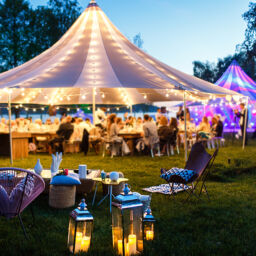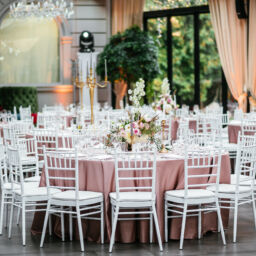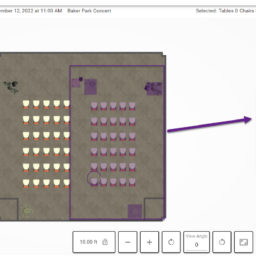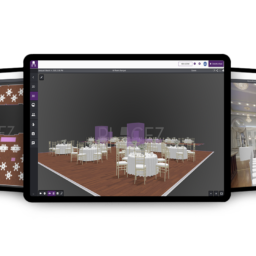Introduction
The art world is evolving, and today’s audiences crave interactive, multisensory experiences rather than passive viewing. Immersive art exhibits and digital installations are at the forefront of this transformation, blending technology, architecture, and creative storytelling to captivate visitors.
From projection mapping and AR-powered exhibits to fully interactive spaces, these experiences require careful venue planning to ensure seamless execution. Venue owners and event planners must consider lighting, spatial design, digital integrations, and audience flow to create an environment that enhances the art rather than limits it.
So, how do you design a venue that supports immersive art? Let’s explore the essential elements of space planning for digital installations and how tools like Placez can help bring these visionary exhibits to life.
Key Elements of an Immersive Venue Space
Creating an environment for immersive art exhibits requires more than an empty room. The right design choices can make an exhibit engaging, functional, and visually stunning.
1. Open Layouts for Interactive Experiences
- Immersive exhibits often require large, flexible spaces to accommodate projections, large-scale sculptures, and interactive installations.
- Open layouts allow free-flowing movement, enabling guests to explore without feeling confined.
2. Flexible Lighting & Projection Mapping
- Proper lighting is crucial, especially for exhibits relying on digital projections and light-sensitive installations.
- Venues should include adjustable, dimmable lighting systems that can complement or disappear based on the artwork’s needs.
- Projection-friendly surfaces (white or neutral walls and seamless screens) are essential for digital art displays.
3. Integration of Digital & Physical Elements
- Many exhibits combine physical sculptures with digital enhancements, such as augmented reality (AR) overlays.
- The venue should support smart technology, including hidden wiring for projectors, motion sensors, and interactive screens.
- 360-degree engagement—allowing visitors to experience art from multiple angles—should be a core design principle.
By planning around these key elements, venue owners can maximize the impact of immersive exhibits while ensuring a smooth guest experience.
The Role of Smart Floor Planning in Immersive Exhibits
The layout of an immersive exhibit can make or break the experience. Smart floor planning ensures:
✔ Optimized audience flow – Avoids bottlenecks and ensures smooth movement between installations.
✔ Strategic spacing – Allows guests to engage with installations without overcrowding.
✔ Thoughtful placement of interactive zones – Ensures key touchpoints are easily accessible.
1. Using Dynamic Layouts to Guide Audience Movement
- Immersive spaces should naturally guide visitors through the experience without feeling forced.
- Curved pathways, visual markers, and lighting cues can direct movement subtly.
- Avoid creating dead zones where guests feel disconnected from the exhibit.
2. How 3D Visualization Tools Help Artists & Curators
- Curators can use 3D modeling tools to test layouts, lighting conditions, and spacing before finalizing a venue design.
- Virtual walkthroughs allow teams to adjust floor plans before installations begin, saving time and resources.
- Tools like Placez help exhibition designers visualize their spaces in real-time 3D, reducing logistical challenges.
Designing for Digital Installations & Projection Art
Digital art installations rely heavily on technology, spatial awareness, and interactive design. Here’s how to optimize venues for these modern exhibits.
1. The Importance of Wall Surfaces & Ceiling Height
- Projection mapping requires smooth, uninterrupted surfaces to avoid distortion.
- Venues with high ceilings allow for larger-scale installations and immersive projection domes.
- Walls should be free of excessive decor or texture to prevent projection interference.
2. Smart Lighting & Digital Displays
- LED lighting, dynamic spotlights, and ambient effects can transform an exhibit into an engaging sensory experience.
- Hidden projectors and light fixtures help maintain the illusion of immersion.
3. AR & VR Integration for Enhanced Engagement
- Augmented reality (AR) exhibits allow guests to interact with digital elements using their smartphones or headsets.
- Placez’s AR capabilities let designers preview how digital installations will look within a space, ensuring a seamless blend of physical and digital art.
Properly designing a venue for digital art ensures that technology enhances the experience rather than becoming a distraction.
How Placez Enhances Venue Design for Immersive Exhibits
Creating an immersive art space requires more than a vision—it requires the right planning tools. Placez transforms how venue owners and exhibit designers plan for digital art installations.
1. 360 Photosphere for Immersive Venue Previews
- Venue managers can preview exhibits in a 360-degree virtual space, allowing curators to experience the layout before installation.
- Helps secure artist approvals, investor buy-in, and event sponsorships with realistic virtual previews.
2. Real-Time 3D Modeling for Dynamic Floor Plans
- Easily adjust layouts for guest flow, installation spacing, and projection zones using 3D tools.
- Experiment with different furniture, display arrangements, and lighting setups before finalizing a design.
3. AR-Powered Presentations for Stakeholders
- Augmented reality (AR) walks clients through an exhibit design in real-time.
- It provides an interactive planning experience, making it easier to refine details before installation.
With Placez, venue managers can plan, visualize, and execute immersive art spaces more efficiently—ensuring a flawless experience for artists and attendees.
Conclusion
As immersive art exhibits and digital installations continue to gain popularity, venue design must evolve to meet their unique needs. By incorporating flexible layouts, smart lighting, and technology-ready spaces, venues can enhance engagement and attract high-profile exhibits.
Tools like Placez allow venue owners, event planners, and curators to design, visualize, and execute these experiences precisely and efficiently.
The future of art is immersive—will your venue be ready for it?
Frequently Asked Questions (FAQs)
1. What makes a venue suitable for immersive art exhibits?
A venue should have open layouts, adjustable lighting, projection-friendly surfaces, and seamless digital integration to support interactive art experiences.
2. How can 3D modeling help plan digital art exhibits?
3D modeling allows curators to visualize layouts, test lighting, and optimize space usage before installation, reducing logistical challenges.
3. What role does AR play in immersive venue design?
Augmented reality (AR) enables virtual walkthroughs of exhibit layouts, helping planners refine designs and secure approvals before installation begins.
4. How can Placez improve immersive exhibit planning?
Placez offers 360 Photosphere previews, real-time 3D modeling, and AR-powered presentations, making designing, adjusting, and optimizing venue layouts easier.
5. Why is immersive art becoming so popular?
Audiences crave interactive, multisensory experiences, making immersive art exhibits a highly engaging and memorable attraction.














